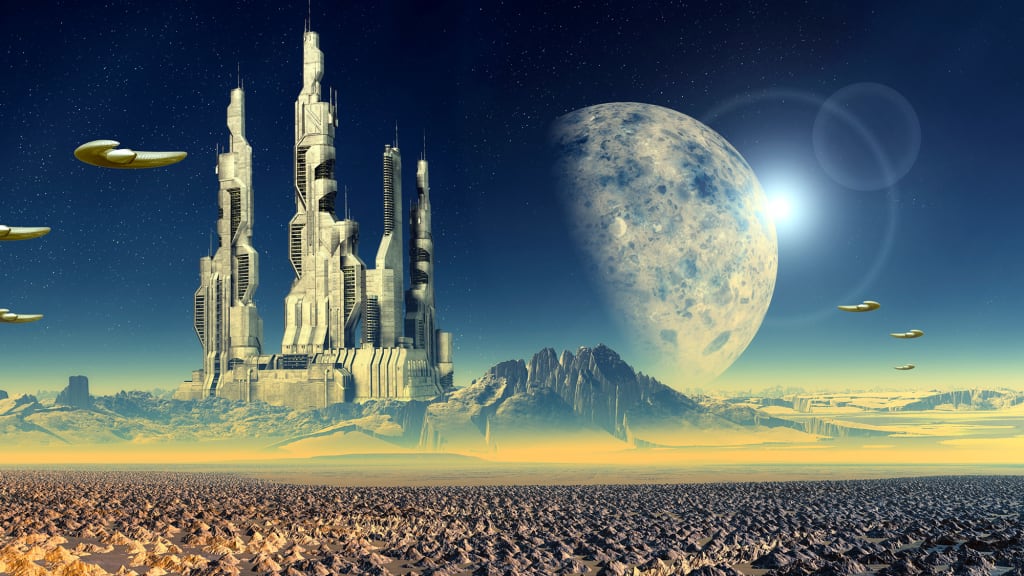What Do Alien Civilizations Look Like? The Kardashev Scale
What Do Alien Civilizations Look Like?

A perceptible universe is a major spot that has been around for in excess of 13 billion years.
Up to two trillion cosmic systems comprised of something like 20,000 billion stars
encompass our home system.
In the Smooth Manner alone,
researchers expect there are about 40 billion earth-like planets
in the tenable zone of their stars.
At the point when we take a gander at these numbers, it's difficult to envision that there is no other individual out there.
It would change our view of ourselves perpetually in the event that we tracked down others.
Simply realizing that this huge spot isn't dead would move our viewpoint outward,
also, could assist us with moving past our insignificant squabbles.
However, prior to searching for our new closest companions, or most terrible adversaries,
we have an issue to tackle: What are we really searching for?
[Kurzgesagt intro]
In a universe that large and old,
we need to expect that civic establishments start a long period of time separated from one another,
furthermore, foster every which way and velocities.
So in addition to the fact that we are investigating distances of handfuls to countless light years,
we're searching for a development going from stone age men to very progressed.
Thus, we want a reasonable system to empower us to think better contemplations
that make us ready to look through better.
Are there widespread principles that insightful species follow?
At present our progress test size is only one,
so we might make erroneous suppositions dependent exclusively upon ourselves.
In any case, not great, but not terrible either than nothing.
We realize that people began with only personalities and hands that could construct instruments.
We realize that people are interested, serious, covetous for assets, and expansionist.
The a greater amount of these characteristics our predecessors had,
the more fruitful they were in the human progress building game.
Being unified with nature is great,
be that as it may, it's not the way to water system frameworks, or explosive, or urban areas.
So it's sensible to accept that outsiders ready to assume control over their home planet additionally have these characteristics.
Furthermore, on the off chance that outsiders need to adhere to similar laws of physical science,
then, at that point, there is a quantifiable measurement for progress: Energy use.
Human advancement can be estimated unequivocally by how much energy we removed from our current circumstance,
what's more, how we made it usable to get things done.
We began with muscles, until we figured out how to control fire.
Then, at that point, we made machines that utilized active energy from water and wind.
As our machines improved and our insight into materials extended,
we started to bridle the concentrated energy from dead plants we uncovered from the beginning.
As our energy utilization developed dramatically, so did the capacities of our progress.
Somewhere in the range of 1800 and 2015, populace size had expanded sevenfold,
while humankind was consuming multiple times more energy.
Almost certainly, this cycle will go on into the far future.
In light of these realities, researcher Nikolai Kardashev fostered a technique for ordering developments,
from cave tenants to divine beings administering over cosmic systems:
The Kardashev Scale; a strategy for positioning civilizations by their energy use.
The scale has been refined and developed throughout the long term,
in any case, overall it places civic establishments into four distinct classifications.
A Sort 1 civilization can utilize the accessible energy of their home planet.
A Sort 2 development can utilize the accessible energy of their star and planetary framework.
A Sort 3 development can utilize the accessible energy of their cosmic system.
A Sort 4 development can utilize the accessible energy of various worlds.
These levels vary by significant degrees.
It resembles contrasting an insect settlement with a human metropolitan region.
To, subterranean insects we are so perplexing and strong, we should be divine beings.
So to make the scale more valuable, we really want subcategories.
On the lower end of the range, there are Type 0 to Type 1 human advancements:
Anything from tracker finders, to something we could accomplish in the following couple of hundred years.
These could really be plentiful in the Smooth Manner.
However, a progress that isn't effectively communicating radio transmissions into space
may be just about as close as our closest heavenly neighbor, the Alpha Centauri framework,
what's more, we would have absolutely no chance of acknowledging they exist.
Be that as it may, regardless of whether they communicated radio transmissions as we do, it probably won't be exceptionally useful.
On an interstellar scale, mankind is essentially undetectable.
Our signs might stretch out over a noteworthy 200 light years,
in any case, this is just a little part of the Smooth Way.
Furthermore, regardless of whether somebody were tuning in,
following a couple of light years our signs rot into clamor,
difficult to recognize as the wellspring of a wise species.
Today, mankind positions at about level 0.75.
We have adjusted our planet:
we've made gigantic designs, mined and stripped mountains,
eliminated rainforests, and emptied out badlands.
We've made streams and lakes,
what's more, changed the arrangement and temperature of the air.
Assuming that headway proceeds, and we don't make Earth dreadful,
we will end up being a full Sort 1 human progress in the following couple of hundred years.
Any progress that turns into a Sort 1 will undoubtedly look outside,
since all things considered, it's as yet inquisitive, cutthroat, ravenous and expansionist.
The following sensible step towards progressing to Type 2 is attempting to change and mine different planets and bodies.
This could begin with stations in space, change to foundation and ventures close to the home planet,
continue on toward provinces, and end with terraforming different planets,
by changing their climate, their revolution, or position.
As a progress grows and utilizes increasingly more stuff and space,
its energy utilization scales with them,
so eventually, they might leave on the biggest venture a lower Type 2 civilization can take on:
outfitting the energy of their star by building a Dyson Multitude.
When this megastructure is done,
energy has become essentially limitless for embellishment the home framework anyway they see fit.
In the event that they are as yet inquisitive, serious, voracious and expansionist,
what's more, presently have unlimited authority over their home framework,
heavenly framework set up, and the energy result of a star,
the following wilderness moves to different stars light years away.
For a Sort 2 progress,
the distance to different stars could feel like the distance among Earth and Pluto does to us today:
In fact reachable,
yet, just with massive interests concerning time, resourcefulness, and assets.
This starts their progress towards Type 3.
This step is such a long ways past us
that it turns out to be difficult to envision what precisely these difficulties will resemble,
also, how they'll be settled.
Can they track down an answer for the immense distances
furthermore, travel seasons of hundreds or millennia?
Can they impart and keep a common culture and science between settlements light years separated?
Or on the other hand will they split into isolated Kind 2 civilizations?
Perhaps various species?
Are there destructive difficulties between the stars?
So the nearer an animal categories will Type 3,
the harder it becomes to comprehend what it could really resemble.
They could find new material science, may comprehend and control dim matter and energy,
or on the other hand have the option to travel quicker than light.
We may not be able to get a handle on their intentions, innovation, and activities.
People are the insects, attempting to figure out the cosmic metropolitan region.
A high Kind 2 civilization could as of now consider humankind excessively crude to try and converse with.
A Sort 3 development could feel probably as like we feel about the microorganisms living on the ant colony dwelling place.
Perhaps they wouldn't actually consider us cognizant, or our endurance pertinent.
We could implore that they're pleasant divine beings.
In any case, the scale doesn't be guaranteed to end here.
A few researchers recommend there may be Type 4 and Type 5 civilizations,
whose impact extends over cosmic system bunches or superclusters,
structures containing large number of cosmic systems and trillions of stars.
At last, there may be a Sort Omega human progress,
ready to control the whole universe, and conceivably others.
Type omega human advancements may be the genuine makers of our universe,
because of reasons outside our ability to grasp.
Perhaps they were recently exhausted.
As imperfect as this arrangement might be,
this psychological study is as of now letting us know intriguing things.
Assuming our thoughts regarding the idea of species that structure interstellar developments is somewhat right,
then we can be almost certain that there are no human advancements of Type 3 and past close to the Smooth Way.
Their impact would no doubt be so comprehensive,
furthermore, their innovation such a long ways over our own, that we were unable to miss them.
The world ought to streak with their action in a huge number of star frameworks.
We ought to have the option to see or identify their ancient rarities or developments between various pieces of their realm.
Regardless of whether a Sort 3 progress exist previously, and kicked the bucket a puzzling demise,
we ought to have the option to identify a portion of the leftovers of their domain.
Yet, when researchers looked, they didn't track down leftovers of collected stars,
rotting megastructures or scars of incredible interstellar conflicts.
So they're possible not out there and never were.
It could be said, this is extremely miserable, yet additionally exceptionally consoling.
It passes on the system to us and others like us.
So the most encouraging developments to search for might be some place in the range from Type 1.5 to Type 2.5.
They wouldn't be excessively exceptional to figure out them and their intentions.
They might have completed their first megastructures,
also, they may be currently moving staff between stars,
sending huge measures of data into space,
unintentionally, or deliberately.
They would likely additionally seek the stars and search for other people.
Of course, perhaps we miss the point entirely.
Perhaps progress to Type 2 doesn't mean growing outwards,
also, humankind is still excessively youthful to envision in any case.
Until further notice, all we truly know is that we haven't seen anyone yet.
However, we've just barely begun looking.
Until we at last track down agreeable super outsiders and can request that they clarify the standards of the universe for us,
About the Creator
SANJOY DAS
person with roles and passions, Dad, friend, Grandpa, and Husband .
Writing ,lending my talents to help others. Spend my energy nurturing my interests and passions. The satisfaction that comes from producing work that inspires me






Comments
There are no comments for this story
Be the first to respond and start the conversation.